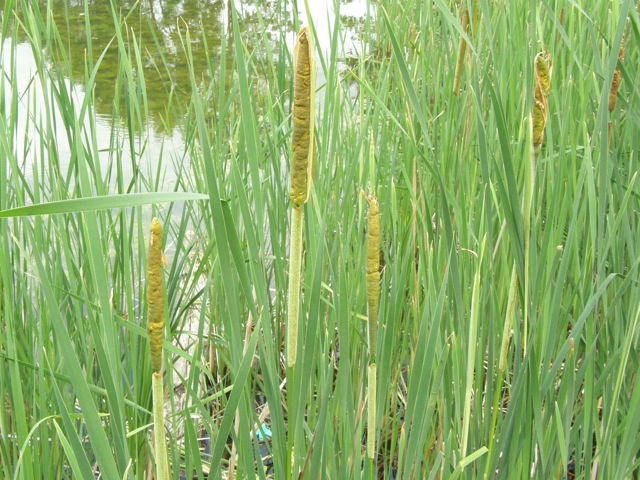Typhaceae, the cattail family.
Description:
Plant:
Long, flat, linear leaves, sheathing the base of, and growing just higher than
a single flower-stalk
that bears a cylindrical spike of minute flowers, 2'-6' high. Perennial.
Flowers:
A cylindrical spike of minute, densely packed flowers on a long stiff stem.
The inflorescence is actually in two parts. Below, are the female flowers
that form a durable cylinder 3/4"-1" in diameter, and up to 8" long.
This eventually disintegrates into fluffy down, but may last well into the
winter. Above is a narrow spike of yellow male flowers that bloom
briefly, and then fall off, leaving a bare spike.
In this species there little or no gap between the female and male flowers.
Leaves:
Long, flat, narrow, to 1" wide, and up to 8' tall,
tough and fibrous. They arise from the base of the plant, and sheath the
flowering stem for some distance.
Fruit:
The female flowers become the brown, cylindrical fruiting body, composed of
densely packed down on minute seeds. This generally remains intact for a
long period of time, and then disintegrates all at once.
Disturbing the mature spike may trigger the process.
Blooming:
Fertile blooms generally present briefly in June or early July.
The distinctive mature spikes remain for months.
Habitat:
Sunny marshes, shallow ponds, and swampy areas.
Comments:
This species often grows intermixed with the [[narrowleaf cattail]]
(T. angustifolia). The latter is distinguished by narrower leaves and
mature spikes and by a distinct gap between the female flowers
and the male ones above.
The plant has a large number of edible parts.
The rootstalks (actually rhizomes) are starchy, and the starch can be
washed out of shredded fresh roots, or sifted from the dried and pounded
article and used, mixed with flour, in cooking.
The underground buds that will sprout to form next year's plants are
also starchy, and can be boiled and eaten.
The pollen often occurs in great profusion, and can be collected by
shaking the blooming spikes into a paper bag.
It can be used as a nutritious additive to flour in baking.
The young leaf-bases can be collected and cooked as a potherb, and the
undeveloped flower spikes cooked at nibbled like corn-on-the-cob.
The mature leaves are tough enough to be used for weaving mats or chair
seats. If not first dried, there is considerable shrinkage in width.
The down is produced in great abundance, and can be used for insulation
or stuffing, though it seems to cause skin irritation in some people.
Where to find it:
Common in shallow water around the pond, and in surrounding marshy areas.
